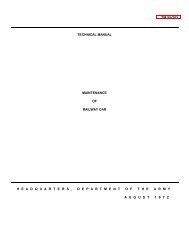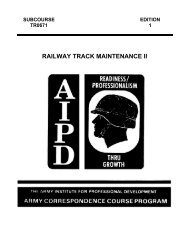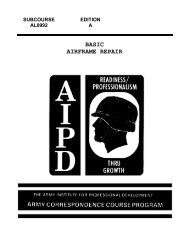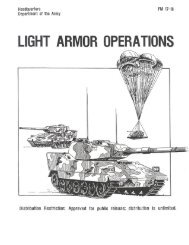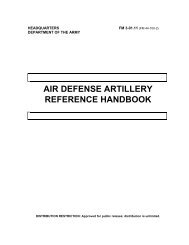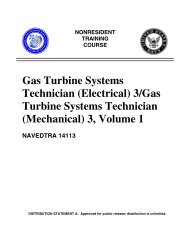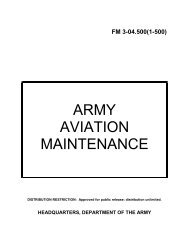fm 44-100 us army air and missile defense operations
fm 44-100 us army air and missile defense operations
fm 44-100 us army air and missile defense operations
You also want an ePaper? Increase the reach of your titles
YUMPU automatically turns print PDFs into web optimized ePapers that Google loves.
CONTROL<br />
FM<strong>44</strong>-<strong>100</strong><br />
modifying, <strong>and</strong> improving the initial versions of courses of action <strong>and</strong> in<br />
developing future courses of action for events that likely are not yet totally<br />
clear.<br />
5-11. Battle comm<strong>and</strong>ers m<strong>us</strong>t be flexible enough to respond to changing<br />
situations <strong>and</strong> to anticipate the dem<strong>and</strong>s of, <strong>and</strong> solutions to, future<br />
<strong>operations</strong>. They m<strong>us</strong>t train themselves, their staffs, soldiers <strong>and</strong> units so<br />
that they are prepared for whatever missions they are assigned.<br />
Comm<strong>and</strong>ers m<strong>us</strong>t be able to visualize the future, formulate concepts,<br />
allocate means, <strong>and</strong> direct the necessary missions required for achieving<br />
victory.<br />
5-12. Comm<strong>and</strong>ers make estimates of future <strong>operations</strong> <strong>and</strong> assessments of<br />
the current situation to determine their own intent <strong>and</strong> formulate the concept<br />
of the operation. The prioritization of actions <strong>and</strong> considerations of the<br />
acceptable degree of risk guides the comm<strong>and</strong>er in determining the amount<br />
of control he can, <strong>and</strong> should, delegate to others to synchronize actions across<br />
the area of <strong>operations</strong>. Comm<strong>and</strong> without freedom of action to subordinates<br />
denies their initiative <strong>and</strong> lessens the ability of the battle comm<strong>and</strong>er to<br />
employ all of his resources to their fullest potential.<br />
5-13. Control is inherent in battle comm<strong>and</strong>. Control is more scientific than<br />
comm<strong>and</strong>. A comm<strong>and</strong>er comm<strong>and</strong>s while the headquarters <strong>and</strong> staffs<br />
coordinate <strong>and</strong> make necessary adj<strong>us</strong>tments consistent with the comm<strong>and</strong>er's<br />
intent. Control monitors the stat<strong>us</strong> of organizational activities, identifies<br />
deviations from the comm<strong>and</strong>er's intent, <strong>and</strong> regulates the forces <strong>and</strong> means<br />
toward an intended aim.<br />
5-14. Control provides the comm<strong>and</strong>er freedom to operate, to delegate<br />
authority, <strong>and</strong> lead from any position on the battlefield, while synchronizing<br />
actions vertically <strong>and</strong> horizontally throughout the AO. Control derives from<br />
underst<strong>and</strong>ing the comm<strong>and</strong>er's intent, implementing good SOPs, training<br />
units <strong>and</strong> soldiers prior to battle, rehearsing, <strong>us</strong>ing graphic control measures<br />
specific to the situation, <strong>and</strong> maintaining continuo<strong>us</strong> dialogue between<br />
comm<strong>and</strong>ers at all levels. Proper control ensures all <strong>operations</strong> are<br />
synchronized <strong>and</strong> s<strong>us</strong>tained throughout their duration. The process of<br />
controlling an organization is directed towards ensuring that the efforts of all<br />
elements are synchronized, adj<strong>us</strong>ting as the situation dictates. However,<br />
foc<strong>us</strong> m<strong>us</strong>t be maintained on the intended end state <strong>and</strong> purpose as<br />
expressed in the comm<strong>and</strong>er's intent. Skilled staffs work within the<br />
comm<strong>and</strong>er's intent to direct <strong>and</strong> control units <strong>and</strong> allocate the means to<br />
support that intent.<br />
5-15. A staff’s role is defined <strong>and</strong> foc<strong>us</strong>ed by the comm<strong>and</strong>er. The staff <strong>and</strong><br />
subordinates assist the comm<strong>and</strong>er in developing, modifying, <strong>and</strong> improving<br />
the initial versions of courses of action based on their expertise.<br />
5-16. The staff performs the fact-filtering <strong>and</strong> development work. But when<br />
completed, it is the comm<strong>and</strong>er who makes the judgment-informed decisions.<br />
It is through the staff <strong>and</strong> battle comm<strong>and</strong> systems that the comm<strong>and</strong>er<br />
exercises control. Staffs compute requirements, allocate means, <strong>and</strong> integrate<br />
efforts. They monitor the stat<strong>us</strong> of organizations, identify variance, correct<br />
5-3




